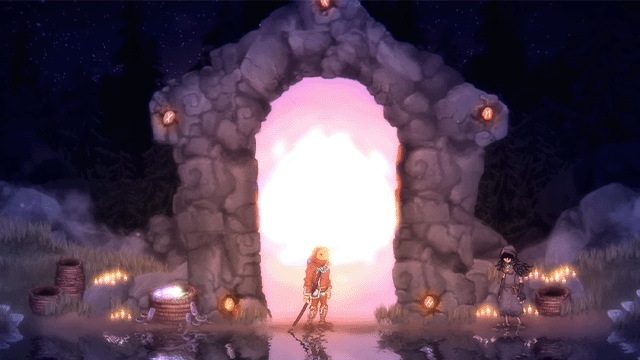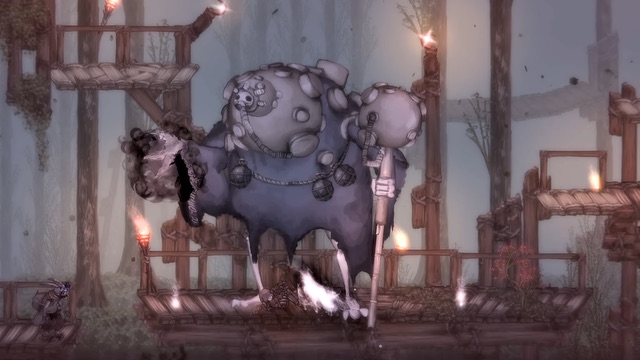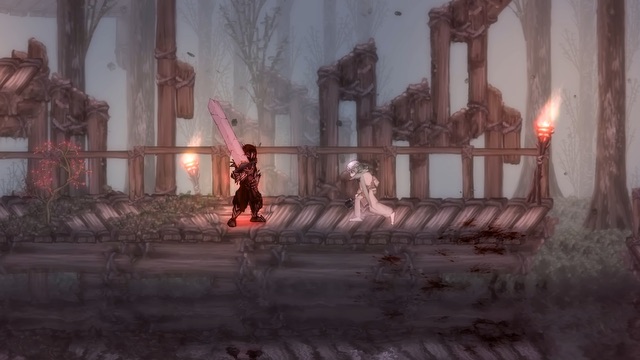Salt and Sanctuary was a hit when it was released approximately six million years ago in 2016. It distilled the gritty atmosphere and challenge of Dark Souls into a leaner 2D package. It also shared that games’ predilection for subtextual storytelling and featured a world that was on its last leg and where little was as it seemed. When I set out to review Salt and Sacrifice, I had hoped for an evolution of the original 2D Soulslike formula. Unfortunately, what we’ve got is different and altogether less satisfying.
Spellbound and Down
The story is considerably less complex this time around. In Salt and Sacrifice, you play as someone that the Alterstone Kingdom has condemned as a criminal. Criminals in the kingdom can choose between two sentences, death or service in the inquisition. Those that choose the latter must live the rest of their lives fighting the scores of rogue mages that torment the kingdom and its people.
Inquisitors must commit to the Magebane Rite, in which they drink a sacred drink, speak an incantation, and then are changed forever. They’re Spellmarked and live in a state between life and death. In exchange for this power, they’re banished from the kingdom forever and crave the taste of the hearts of mages.
That’s pretty much it. You’ll meet other inquisitors, and there are still snippets of lore text found throughout, but the story lacked the mystery that hooked me in the first one. Most NPCs are surprisingly forthcoming and generally helpful and chatty. Most of them are fairly one-dimensional, and their “crimes” are hardly worth mentioning.
Your main foes throughout the game, the mages, also lack the lore we expect from Soulslikes. I thought that maybe there was more nuance in the conflict between the Alterstone Kingdom and the mages, but it never really comes to much.
Building Frustration
 The gameplay loop in Salt and Sacrifice is similar to that found in its predecessor, but some key differences give it a much different feel. The world is no longer one large, contiguous map. Instead, it’s split into discrete areas, which are unlocked in a fairly linear fashion. There’s still plenty of exploration to be had as each location is relatively expansive, but that’s not actually a positive for this game.
The gameplay loop in Salt and Sacrifice is similar to that found in its predecessor, but some key differences give it a much different feel. The world is no longer one large, contiguous map. Instead, it’s split into discrete areas, which are unlocked in a fairly linear fashion. There’s still plenty of exploration to be had as each location is relatively expansive, but that’s not actually a positive for this game.
The game centers around Mage Hunts, which are more like Monster Hunter than Dark Souls. Within each area, there are several clues that you need to find through exploration. These will allow you to start a Mage Hunt in which you’ll need to track a mage by following their spectral trail. As you chase them, they’ll summon enemies to stop you and take a few potshots before running away again. During this time, you can cause damage to them, but you can’t take them down until they turn to face you.
At this point, things turn into a proper boss fight. Mages’ health bars don’t reset when the battle starts, so if you were able to maximize your damage during the chase, it’ll be that much easier to take them down. Once you do, you can consume their heart and gather any unique crafting items they drop. Some doors throughout the game require you to devour a certain amount of hearts. So, by killing mages, you can explore more, which leads to more mages to kill, and eventually, you’ll head to another area.
Unfortunately, the chases themselves can be incredibly frustrating and are too susceptible to random chance. For example, during my first Mage Hunt, I ran into two mages simultaneously, which vastly increased the difficulty in tracking the right one down. Furthermore, since this meeting was entirely due to chance, there was no way to prepare for it.
Like Dark Souls, your primary source of healing has a limited amount of charges, and chasing a mage down can sometimes take a ridiculous amount of time. If you hit bad RNG, then by the time you can face a mage in a proper battle, you’ll lack the healing items to get a fair chance.
Not on the Fast Track
As I said above, there are plenty of areas to explore, but because the game is designed around chasing mages throughout a level, there’s no fast travel, which means you have to grind through the same map over and over again with no checkpoint system to take some of the frustration out of it. If you return to your camp to upgrade weapons or craft, then you start right back at the start of an area when you teleport back in.
It would be a bit less frustrating if you could track mages with a map and at least know exactly where you had to go, but you don’t. The spectral line you have to follow gets a bit vague at times as well, and the mages are constantly on the move, so it’s easy to overshoot them and go to a room that’s too high or low relative to where they are.
The main problem seems to stem from the fact that Salt and Sacrifice is designed around co-op gameplay. Everything is geared around you fighting and exploring together with someone else, from the story to exploration and combat. It seems like a weird choice, given that the original game was devoid of multiplayer and is detrimental to the overall package.
Salt and Sacrifice Review: The final verdict
Unfortunately, Salt and Sacrifice discarded way too much to place the focus on multiplayer. The aspects I do like, the exploration and combat, are carried over from the original game. The core Mage Hunt gameplay loop is tedious, and the lack of fast travel made me sick of seeing the same scenery repeatedly. You’ll probably find something to love here if you have a friend to place this game with and enjoy the original. However, as a solo adventure, it’s severely lacking.
-
Decent multiplayer experience.
-
Combat and upgrade systems are enjoyable.
-
Mage Hunts are tedious.
-
No fast travel or map slows down the game.
-
Story isn't nearly as engaging as the original's.









